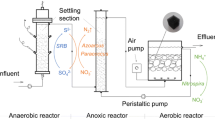Abstract
To explore the applicability of anoxic-oxic (A/O) activated sludge process for petrochemical wastewater treatment, the relationship between bacterial community structure and pollutants loading/removal efficiencies was investigated by gas chromatograph-mass spectrometry (GC-MS), polymerase chain reaction-denaturing gradient gel electrophoresis (PCR-DGGE) and other conventional techniques. It showed that when the concentrations of the influent chemical oxygen demand (COD) and ammonia nitrogen (NH +4 -N) were 420∼560 mg/L and 64∼100 mg/L, respectively, the corresponding average effluent concentrations were 160 mg/L and 55 mg/L, which were 1.6 and 2.2 times higher than those of the national standards in China, respectively, demonstrating the inefficient performances of A/O process. Analysis of GC-MS indicated that refractory pollutants were mainly removed by sludge adsorption, but not by biodegradation. PCR-DGGE profile analysis suggested that the biological system was species-rich, but there was apparent succession of the bacterial community structure in different locations of the A/O system. Variations of bacterial community structure and pollutant loadings had obvious influences on pollutants removal efficiencies. Thus, A/O process was inapplicable for the treatment of complicated petrochemical wastewater, and strategies such as the reinforcement of pre-treatment and two-stage A/O process were suggested.
Similar content being viewed by others
References
Buchholz-Cleven, B.E.E., Rattunde, B., Straub, K.L., 1997. Screening for genetic diversity of isolates of anaerobic Fe(II)-oxidizing bacteria using DGGE and whole cell hybridization. Systematic and Applied Microbiology, 20:301–309.
Eichner, C.A., Erb, R.W., Timmis, K.N., 1999. Thermal gradient gel electrophoresis analysis of bioprotection from pollutant shocks in the activated sludge microbial community. Applied and Environmental Microbiology, 65(1): 102–109.
Gao, P.P., Zhao, Y., Zhao, L.P., 2003. Analysis of the microbial community of activated sludge in different aeration basins within an industrial phenol remediation system by ERIC-PCR fingerprinting. Acta Scientiae Circumstantiae, 23(6):705–710 (in Chinese).
Hansen, M.C., Tolkernielsen, T., Givskov, M., Molin, S., 1998. Biased 16S rDNA PCR amplification caused by interference from DNA flanking the template region. FEMS Microbiology Ecology, 26(2):141–149. [doi:10.1111/j.1574-6941.1998.tb00500.x]
Lapara, T.M., Nakatsu, C.H., Pantea, L.M., Alleman, J.E., 2002. Stability of the bacterial communities supported by a seven-stage biological process treating pharmaceutical wastewater as revealed by PCR-DGGE. Water Research, 36(3):638–646. [doi:10.1016/S0043-1354(01)00277-9]
Ling, W.H, Xiao, Y.C., 2003. Application of up-flow anaerobic sludge bed in the pretreatment of high concentrated wastewater of petroleum chemical production. Shanghai Chemical Industry, 8:7–10 (in Chinese).
Liu, G.L., Chong, Y.X., Fan, Q.J., Jia, X.S., Li, S.H., 2006. Hydrodynamic effects of the oxidation ditch on the removal efficiency and energy consumption. Environment Science, 27(11):2323–2326 (in Chinese).
Margesin, R., Schinner, F., 1999. Biodegradation of diesel oil by cold-adapted microorganisms in presence of sodium dodecyl sulfate. Chemosphere, 38(15):3463–3472. [doi:10.1016/S0045-6535(98)00575-X]
Marsh, T.L., Liu, W.T., Forney, L.J., Cheng, H., 1998. Beginning a molecular analysis of the eukaryal community in activated sludge. Water Science and Technology, 37(4–5): 455–460. [doi:10.1016/S0273-1223(98)00145-0]
Myers, R.M., 1985. Modification of the melting properties of duplex DNA by attachment of a GC-rich DNA sequence as determined by denaturing gradient gel electrophoresis. Nucleic Acids Research, 13(9):3111–3129. [doi:10.1093/nar/13.9.3111]
Nyholm, N., 1996. Biodegradability characterization of mixtures of chemical contaminants in wastewater—the utility of biotests. Water Science and Technology, 33(6):195–206. [doi:10.1016/0273-1223(96)00326-5]
Orphan, V.J., Taylor, L.T., Hafenbradl, D., Delong, E.F., 2000. Culture-dependent and culture-independent characterization of microbial assemblages associated with high-temperature petroleum reservoirs. Applied and Environmental Microbiology, 66(2):700–711. [doi:10.1128/AEM.66.2.700-711.2000]
Patel, H., Madamwar, D., 2002. Effects of temperatures and organic loading rates on biomethanation of acidic petrochemical wastewater using an anaerobic upflow fixed-film reactor. Bioresource Technology, 82(1):65–71. [doi:10.1016/S0960-8524(01)00142-0]
Ren, N.Q., Ma, F., 2003.Theory and Application of Microbiology for Pollution Control. Chemical Industry Press, Beijing, p.64–68 (in Chinese).
SEPAC (State Environmental Protection Administration of China), 2002. Water and Wastewater Analytical Methods (4Ed.). China Environmental Press, Beijing (in Chinese).
Shi, L.J., Xun, Y.X., Yang, F.L., Zhang, X.W., Wang, X.J., Kenji, F., 2006. Biological nitrogen removal from petrochemical wastewater using anoxic and oxic swim-bed reactor. Journal of Chemical Industry and Engineering, 57(1):104–108 (in Chinese).
SSB (State Standard Bureau), 2002. Discharge Standard of Pollutants for Municipal Wastewater Treatment Plant GB18918-2002. Standards Press of China, General Administration of Quality Supervision, Inspection and Quarantine of the People’s Republic of China (in Chinese).
Wen, Y., Huang, X.F., Qiu Z., Wang F., Zhang, F.J., Zhou, Q., 2006. Experimental study on the mechanism of oilfield wastewater treatment by using hydrolysis-acidification with aerobic biological process. Chinese Journal of Environmental Science, 27(7):1362–1368 (in Chinese).
Xue, L.H., 2002. Transfer and transformation of the organic compound in the process of treating municipal wastewater. Journal of Safety and Environment, 2(5):45–47 (in Chinese).
Author information
Authors and Affiliations
Corresponding author
Additional information
Project supported by the National Basic Research Program (973) of China (No. 2004CB418505) and the Science and Technology Development Program of Heilongjiang Province (No. CC05S301), China
Rights and permissions
About this article
Cite this article
Zhao, Lj., Ma, F. & Guo, Jb. Applicability of anoxic-oxic process in treating petrochemical wastewater. J. Zhejiang Univ. Sci. A 10, 133–141 (2009). https://doi.org/10.1631/jzus.A0820006
Received:
Accepted:
Published:
Issue Date:
DOI: https://doi.org/10.1631/jzus.A0820006
Key words
- Petrochemical wastewater
- Polymerase chain reaction-denaturing gradient gel electrophoresis (PCR-DGGE)
- Anoxic-oxic (A/O) process
- Applicability




